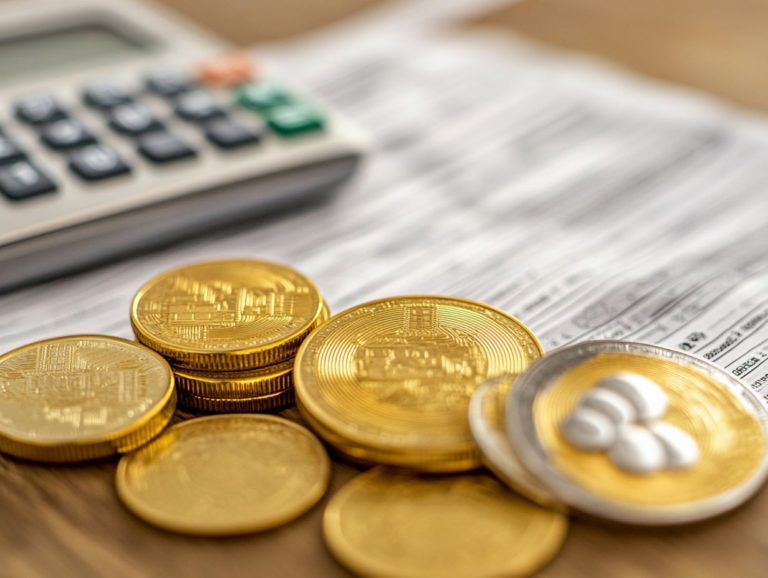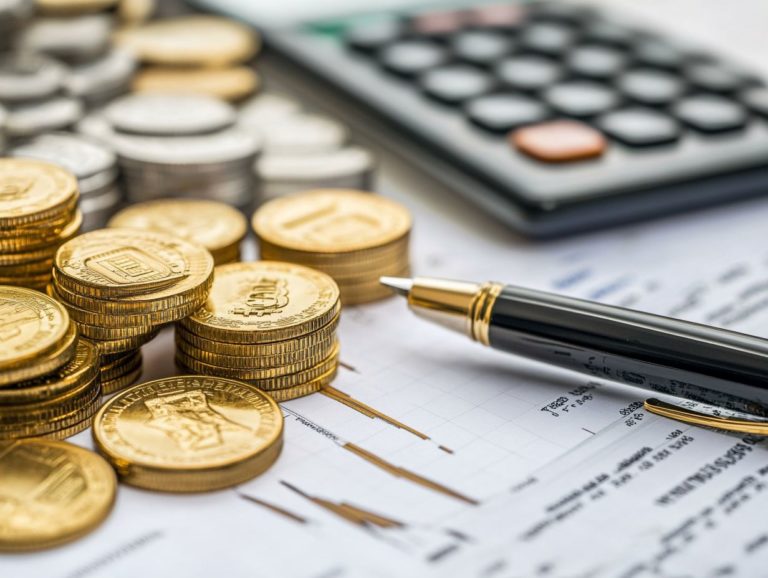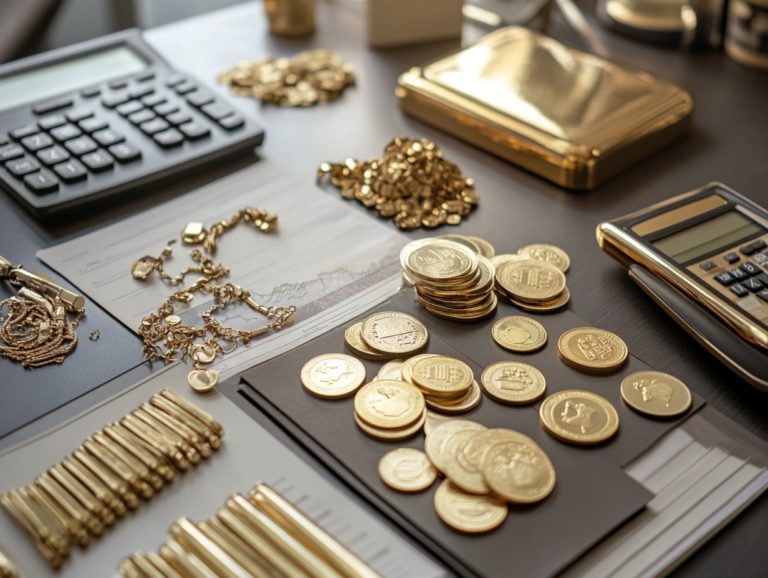How to Handle Tax Liabilities on Precious Metals Sales
Navigating the tax landscape surrounding precious metals sales may seem daunting. However, grasping your obligations is vital for any investor.
This guide demystifies the complexities of tax laws and regulations related to gold, silver, platinum, and other metals. It provides clarity on potential capital gains, details how to calculate and report these gains, delves into tax strategies that can help minimize liabilities, and highlights common pitfalls you should avoid.
Equip yourself with the essential knowledge to make informed decisions and maximize your investment returns.
Contents
- Key Takeaways:
- Understanding Tax Liabilities on Precious Metals Sales
- Types of Precious Metals and Tax Implications
- Calculating and Reporting Capital Gains on Precious Metals Sales
- Tax Strategies for Reducing Liabilities on Precious Metals Sales
- Common Mistakes to Avoid
- Frequently Asked Questions
- What is considered a precious metal for tax purposes?
- How are tax liabilities calculated on precious metals sales?
- Do I have to report precious metals sales on my tax return?
- Are there any exemptions for tax liabilities on precious metals sales?
- What happens if I don’t pay tax on my precious metals sales?
- Can I deduct expenses related to my precious metals sales?
Key Takeaways:
- Be aware of tax laws and regulations surrounding the sale of precious metals to avoid potential penalties and fees.
- Different types of precious metals may have varying tax implications, so it’s important to understand the specific rules for each metal.
- Properly calculating and reporting capital gains on precious metals sales can help minimize tax liabilities and ensure compliance with tax laws.
Understanding Tax Liabilities on Precious Metals Sales
Understanding the tax liabilities associated with precious metals sales is essential for you as an investor aiming to optimize your returns in today s intricate financial landscape. This is especially pertinent when considering the Sprott Physical Bullion Trusts and the various forms of taxation, including capital gains tax, sales tax, and U.S. federal income tax.
The tax implications vary significantly depending on whether you’re dealing with physical gold, physical silver, or precious metals ETFs. Understanding these nuances, including the complex tax issues in precious metals investments, empowers you to manage your investments effectively and enhance your overall strategy.
Overview of Tax Laws and Regulations
An overview of tax laws and regulations concerning precious metals unveils the intricate landscape of capital gains tax, collectibles tax rates, and the impact of U.S. federal income tax on taxable investors. This is especially important for those understanding how Passive Foreign Investment Corporations work. Each of these factors is pivotal in shaping the tax environment for your precious metals investments.
Understanding these regulations is essential for maximizing your investment returns. For example, while the standard capital gains tax applies to most assets, the collectibles tax rate can climb to a staggering 28% for specific types of precious metals, including certain coins and bullion. To navigate this complex landscape, it’s important to consider the tax implications of precious metals in different states.
Federal sales tax also differs depending on state regulations, adding another layer of complexity to your investment decisions. You must comply with IRS regulations to avoid hefty penalties, underscoring the necessity of staying informed about evolving tax laws and seeking trustworthy tax advice. Understanding the tax advantages of retirement accounts for precious metals can also be beneficial in your planning.
Types of Precious Metals and Tax Implications
When investing in precious metals like gold, silver, platinum, and palladium, it’s crucial to recognize the distinct tax implications associated with each. Understanding these nuances will help you navigate the complexities of your investments with confidence.
Whether you’re handling physical gold, physical silver, or investment-grade collectibles, be aware that each type may incur different capital gains tax obligations upon sale. Understanding the future of taxation in precious metals investment is key to maximizing your returns and minimizing unforeseen expenses.
Gold, Silver, Platinum, and Other Metals
When considering the tax implications of investing in precious metals like gold, silver, platinum, and palladium, you ll find that each metal comes with its own set of unique factors. This is especially true regarding capital gains tax and collectibles tax rates that apply to both physical and investment forms of gold. Grasping these nuances is crucial for making informed investment decisions.
As an investor, it’s wise to tread carefully. Capital gains tax can vary significantly depending on the type of metal and how you hold it. For example, physical gold and silver are generally classified as collectibles, meaning they could be subject to a higher tax rate of up to 28% upon sale for a profit. To navigate these complexities, consider exploring tax strategies for precious metals in a diversified portfolio.
On the flip side, platinum and palladium may qualify for capital gains tax rates that typically range from 0% to 20%, influenced by your income level. To alleviate potential tax burdens, consider strategies such as holding your metals in a self-directed IRA, an account that lets you manage your own investments while enjoying tax benefits. Additionally, exploring the tax benefits of holding precious metals in a trust can further enhance your financial strategy. This approach not only facilitates tax-deferred growth but also protects your investments from immediate tax implications.
Start your journey in precious metal investment today!
Calculating and Reporting Capital Gains on Precious Metals Sales
Calculating and reporting capital gains (the profit you make when selling an asset for more than you paid for it) from precious metals sales is essential for you as an investor. You need to understand the details of IRS Form 8621 and the distinctions between short-term and long-term capital gains, as they directly impact your net capital gains.
Accurately reporting these gains on your tax return can significantly impact your investment income. Understanding the relationship between precious metals and capital gains tax can help optimize your financial outcomes and reduce tax liabilities.
Step-by-Step Guide
This step-by-step guide will empower you to work through the details of calculating capital gains taxes related to your precious metals sales. It offers clarity on how to use IRS Form 8621 for accurate reporting and compliance. Each step is crucial to ensure your tax return accurately reflects your investment performance.
- First, determine the purchase price of your precious metals. This serves as the baseline for your investment.
- Next, establish the sale price when you divest these assets.
- The difference between these two prices, after deducting any associated costs, will provide you with your capital gain.
Understanding the holding period is equally vital, as it can influence the tax rate applied to your gains. When using IRS Form 8621, you’ll need to input this information systematically. Careful record-keeping is highly recommended to support your filings and ensure that all transactions are documented for future tax returns.
Tax Strategies for Reducing Liabilities on Precious Metals Sales
Use effective tax strategies to reduce liabilities on your precious metals sales. This can significantly lower your capital gains tax burden, unlocking essential tax advantages for your investments.
Collaborating with a knowledgeable tax advisor is crucial. They can help you uncover opportunities for minimizing tax liabilities on precious metals and optimize your investment strategies, ensuring you make the most of your assets.
Maximizing Deductions and Credits
Maximizing deductions and credits is essential for reducing tax liabilities as a precious metals investor. By capitalizing on available tax advantages, you can significantly lower your overall tax burden.
For instance, you should definitely consider claiming management fees paid to financial advisors or investment firms, as these costs are often deductible. You can also reduce your taxable income with expenses related to storage, like safe deposit box fees or insurance for your metals. Additionally, it’s important to be aware of the tax regulations for precious metals in retirement accounts to ensure compliance and maximize your benefits.
By tracking these expenditures diligently, you can considerably lower your taxable gains. Just imagine if you invested in gold and incurred $1,000 in management fees and $500 for storage costs. Those deductions could lead to significant tax savings, especially when you consider the basics of tax loss harvesting in precious metals, ultimately enhancing the overall return on your investment.
Common Mistakes to Avoid
Avoiding common mistakes in precious metals sales is crucial for ensuring accurate reporting and compliance with capital gains tax regulations. Even small mistakes can lead to big tax bills or penalties from the IRS! Be careful.
As an investor, maintaining vigilance in your investment management practices is essential to ensure compliance and safeguard your financial interests.
Tips for Accurate Reporting and Compliance
To ensure accurate reporting and compliance with IRS regulations regarding capital gains taxes, you must employ effective strategies for tracking your transactions and documenting sales of precious metals. This involves keeping detailed records of every purchase and sale. Make sure to save your receipts as proof.
By establishing a systematic approach to documentation, you can better prepare for tax season, making it significantly easier to compile the necessary information when filing your returns. It s wise to consult a tax advisor who can guide you through the intricacies of capital gains tax laws, ensuring that you remain compliant with IRS guidelines while maximizing all eligible deductions.
Start your documentation today to prepare for a stress-free tax season!
Frequently Asked Questions
What is considered a precious metal for tax purposes?
Precious metals typically subject to tax liabilities when sold include gold, silver, platinum, and palladium.
How are tax liabilities calculated on precious metals sales?
Tax liabilities on precious metals sales are calculated based on the profit made from the sale. You can find this profit by subtracting the original purchase price from the selling price.
For example, if you bought a gold coin for $1,000 and sold it for $1,200, your profit would be $200.
Do I have to report precious metals sales on my tax return?
Yes, any gains from selling precious metals must be reported on your tax return. This income is taxable, so act now to avoid potential penalties!
Are there any exemptions for tax liabilities on precious metals sales?
Some exemptions may apply based on the type of precious metal sold and the circumstances surrounding the sale. Consult a tax professional for specific information on exemptions.
What happens if I don’t pay tax on my precious metals sales?
If you fail to pay taxes on your precious metals sales, the IRS may impose penalties and interest on the amount owed. In serious cases, this can lead to legal action against you.
Don t forget, you can deduct expenses related to your sales! This includes costs like shipping and handling fees. These deductions can help lower your overall tax liability on the sale.















